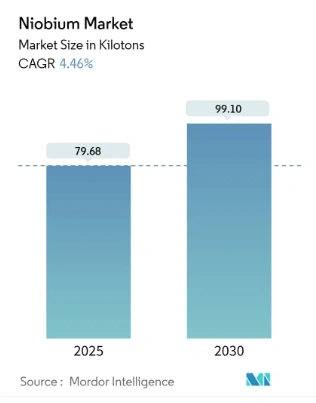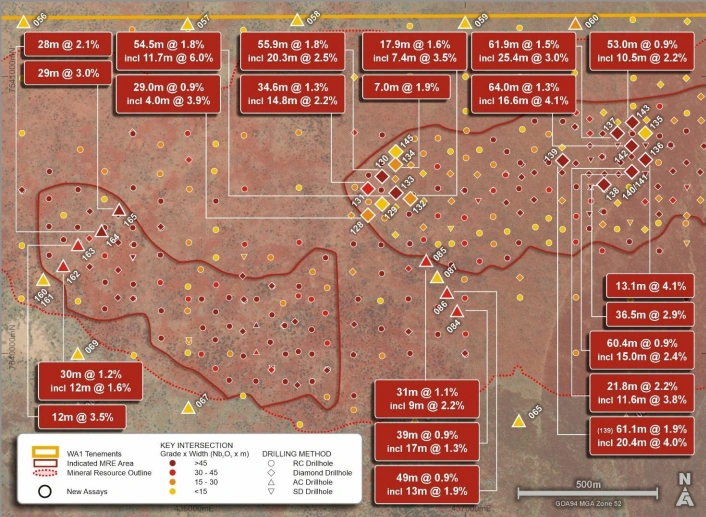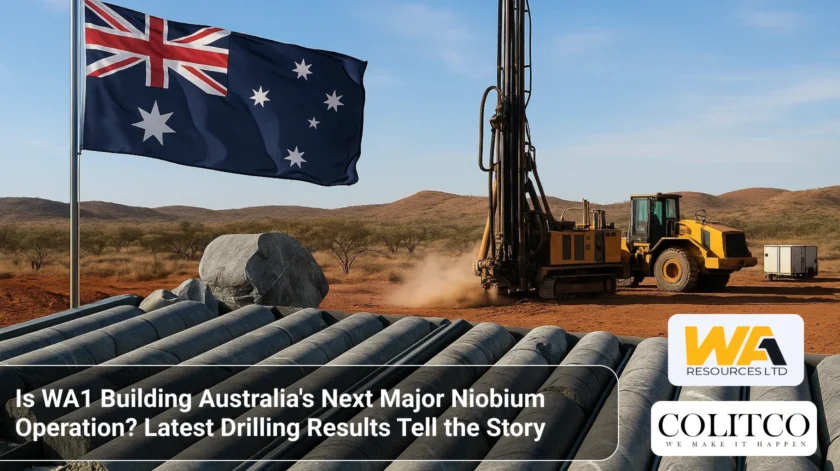WA1 Resources (ASX: WA1) just dropped drilling results that have investors asking one question: how big can this get?
The Perth-based explorer released assays from 49 holes at its Luni Niobium Project in Western Australia. Among them, intercepts hitting 6.0% Nb₂O₅ over 11.7 metres and 4.1% Nb₂O₅ over 16.6 metres.
These aren’t your typical grades. They’re exceptional by global standards.
What makes this particularly interesting? The mineralisation starts at surface. It’s shallow. It’s oxide-enriched. And it remains open to the east.
WA1’s Managing Director Paul Savich put it plainly: “Assay results from this year’s drilling have continued to affirm the continuity of the key higher-grade zones.”
The Company has now completed over 80,000 metres of drilling since discovery. Three rigs are currently operating. An updated Mineral Resource Estimate is targeted for 2026.
But here’s the part that matters most—niobium isn’t just another commodity.
Why Niobium Matters Right Now
Global niobium demand is forecast to reach 99.10 kilotons by 2030, growing at a CAGR of 4.46% from 2025. The market was valued at $2.08 billion in 2024 and is expected to reach $3.23 billion by 2032.
Niobium Market Size and Share

Niobium Market Size and Share
The drivers are clear:
- Infrastructure boom: Niobium-enhanced steel reduces material use by 30% while increasing strength
- Automotive lightweighting: Modern vehicles now contain 1.8 kg of niobium per tonne of steel
- Aerospace demand: Jet engine components require niobium for extreme temperature performance
- Battery technology: CBMM’s battery-grade niobium oxide for EV cathodes represents emerging growth
Brazil currently supplies approximately 88% of global niobium production, primarily from CBMM’s Araxá mine. This concentration creates significant supply vulnerability.
Australia has noticed. The federal government’s $1.2 billion Critical Minerals Strategic Reserve specifically targets supply chain diversification.
WA1’s Luni Project fits squarely into that strategy.
What the Drilling Shows
The latest results confirm what geologists suspected: high-grade zones aren’t isolated hits, they’re continuous.
Key intercepts from the October 9th release include:
- LUDD-0133: 11.7m @ 6.0% Nb₂O₅ from 38.0m
- LUDD-0142: 16.6m @ 4.1% Nb₂O₅ from 54.2m
- LUDD-0137: 25.4m @ 3.0% Nb₂O₅ from 31.9m
- LUDD-0138: 36.5m @ 2.9% Nb₂O₅ from 36.5m
- LUAC-0165: 29m @ 3.0% Nb₂O₅ from 55m
The mineralisation is sub-horizontal. True widths approximate drilled intervals. Core recovery has been moderate to excellent through mineralised zones.
Metallurgical testwork delivered gold recoveries of up to 99.5%. Fast leach kinetics. Low reagent consumption.
These technical details translate into one thing: potential for low-cost production.

Luni central plan view with drill collar locations and new niobium intersections
Infrastructure and Permitting Progress
WA1 isn’t waiting. Pre-development works have commenced.
The Company is constructing a development airstrip. Water production bores are being installed. Two diamond rigs are focused on resource definition while a third handles geotechnical and metallurgical sampling.
Heritage and environmental surveys continue with Traditional Owner groups. The Company describes relationships as “strong.”
Environmental referral and assessment with government departments is progressing.
For context, St George Mining’s Araxá Project in Brazil recently delivered similar high-grade niobium results, demonstrating investor appetite for well-located carbonatite-hosted deposits.
The Commercial Case
Niobium products are typically sold through direct contracts between producers and consumers, resulting in more stable pricing but less market transparency. Pricing is influenced by production costs and strategic considerations rather than speculative trading.
Projects with higher-grade deposits (typically above 1% Nb₂O₅), favorable mineralogy, good infrastructure connections, and established offtake relationships tend to demonstrate superior commercial potential.
Luni’s intercepts of 6% and 4.1% Nb₂O₅ represent exceptionally high grades by global standards.
The project sits in Western Australia’s established mining jurisdiction. Road access exists. Power infrastructure is within reach. Skilled labour is available.
Australia’s Critical Minerals Strategy 2025 provides additional policy support through offtake agreements and financing mechanisms.
Market Response
WA1 Resources has delivered strong returns for shareholders. The stock traded around $19.81 in early October 2025, with a market capitalisation approaching $950 million.
The 52-week range spans $9.80 to $19.98, reflecting growing recognition of Luni’s potential.
With niobium gaining recognition as a critical mineral globally, projects in stable jurisdictions are attracting institutional attention.
What Comes Next
The 2026 Mineral Resource update will be the next major catalyst. WA1’s drilling program specifically targets converting Inferred resources to Indicated category in the eastern focus zone.
This matters for project financing. Indicated resources carry higher confidence. They support engineering studies. They underpin offtake negotiations.
Pre-Feasibility and Definitive Feasibility studies will follow.
For investors, the question isn’t whether niobium demand will grow; it’s which projects will capture that growth.
WA1’s Luni Project is positioning itself to be one of them.
Also Read: Mineral Resources Strengthens Board Independence with Veteran HR Executive and Mining Expert
Frequently Asked Questions
Q: What makes niobium a critical mineral?
A: Niobium is essential for high-strength steel used in infrastructure, automotive, and aerospace applications. With 88% of supply from Brazil, diversification is a strategic priority for Western economies.
Q: How does WA1’s niobium project compare globally?
A: Luni’s grades of 6% and 4.1% Nb₂O₅ are exceptional by global standards. Most economic deposits range from 1-3% Nb₂O₅.
Q: When will WA1 update its Mineral Resource Estimate?
A:The Company is targeting an updated MRE in 2026, incorporating over 80,000 metres of drilling completed to date.
Q: Is niobium demand growing?
A:Yes. Global demand is forecast to grow at 4-6% annually through 2030, driven by infrastructure development, automotive lightweighting, and emerging battery applications.
Q: What is WA1’s current market capitalisation?
A:As of October 2025, WA1’s market cap stands at approximately $950 million, with shares trading near $19.81.












